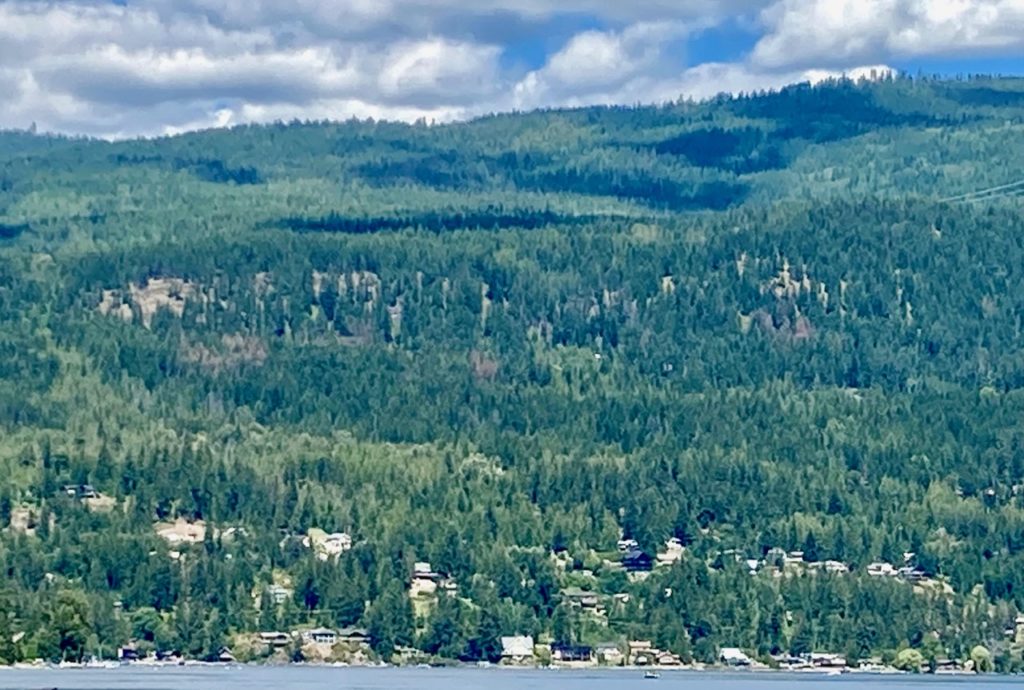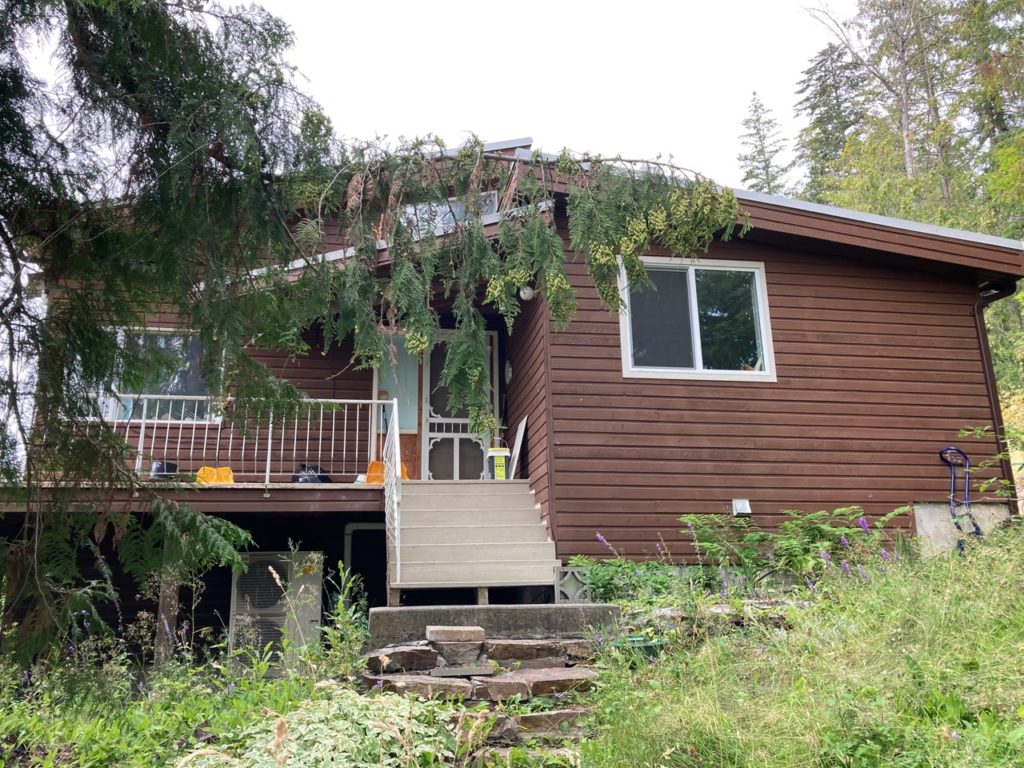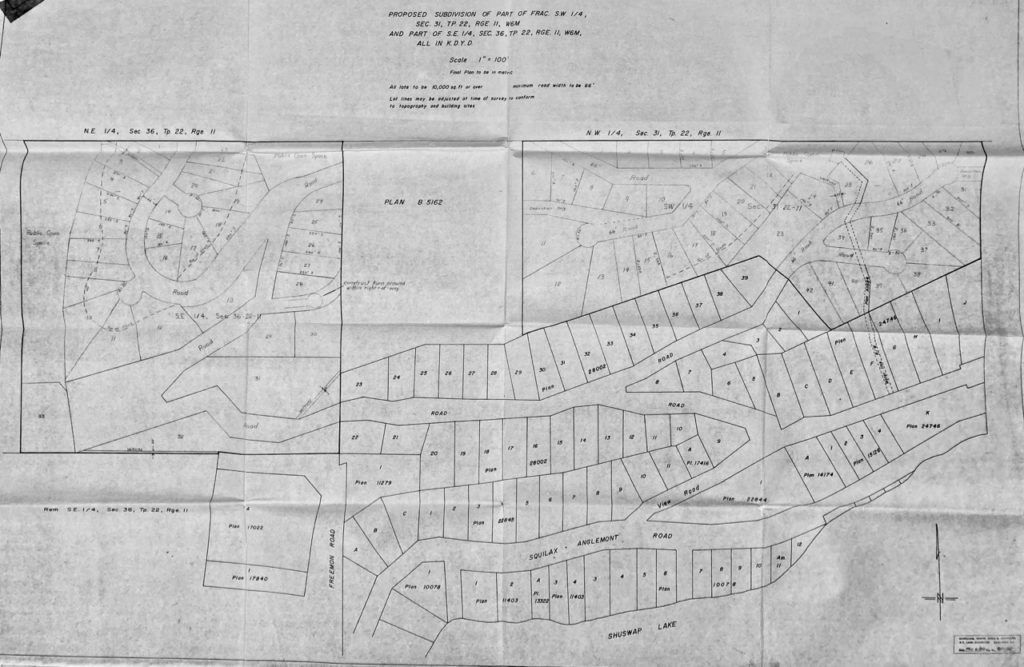
Mike Riley began his subdivision in earnest, with plans for three phases. The first phase, which began in 1973, focused on the highway and View Road, where his mother Beatrice had already sold a few lots on the lake side of the road. Due to the steep hillside on the northside, the building sites were located above the road and while the address for these lots was on View Rd. the actual access was a narrow unpaved alley off of Hopwood Road. Likely the first house built in the first phase is the home below the cliff on the north side of View Rd.
To market the lots, a small sales office was built on the highway across from the water intake. It quickly became obvious that the office was not attracting much attention from the highway traffic, so it became a storage building. Despite the low prices for the lots, between two and three thousand dollars, sales were slow, and many were purchased as investments by Mike’s friends and associates.

Once the water pipes were laid, marketing began for the second phase along both Hopwood and Lee Creek Drive. Tom Campbell built one of the first homes in the second phase on the corner lot where Hopwood meets Lee Creek Drive for a teacher, Jean Lindsey, from Haldane Elementary. Crichton Campbell, Tom’s son, purchased his first lot in 1978, and by that time the lot price had increased to $8,000.
The third phase presented many challenges, beginning with building the road up the steep hillside to the switchback, where Mike had set up a gravel crusher to provide road mulch. When the first attempt was rejected by the Ministry of Highways and Transportation for being too steep, Mike had to bring in a compressor for blasting the rock. After a second attempt was rejected, it took more blasting and bulldozing until the Ministry was satisfied with the grade.
The major challenge for the third phase was developing a water supply, as the proposed lots were higher than the water tanks installed for the first two phases. Mike managed to obtain a water licence for a substantial supply from Freeman Brook and he obtained a lease from the government for one acre of land below the bluff for a reservoir.

In an effort to find a way to access the water he used his bulldozer in an attempt to cut a road from above the bluffs down to where he had cleared the area to store the water. Predictably, his effort to defy the geography failed, as the ground was too steep. He then cut a ditch from Freeman Brook to his reservoir site, however that attempt failed too because it is a seasonal creek, and the reservoir did not retain the water.
One of the selling features of the Anglemont subdivision in the 1970s was its air strip and Mike likely thought having one at Lee Creek would benefit sales. The Crown land below the bluff is quite flat and Mike applied for a lease to build an air strip on it. The government rejected his application for good reasons, one of them being if a plane overshot the runway, it could have ended up in the Lee Creek Canyon. To this day, we refer to this area as “the airport!”
By the end of the 1970s, a great deal of money had been spent paving the roads and installing water pipes for phase three of Lee Creek Heights, with nothing to show for it because the pipes were still dry. Mike needed an out, thus the uncompleted third phase of the subdivision, totalling approximately 50 acres, was sold to its two major investors, Bernie Gagne and Irwin Eisler. They decided that the only way to provide water was to build a concrete reservoir and pump up from the lake. A hole was dug on the leased acre and forms were built, but by this time it was the early 1980s and the economy was in tatters with interest rates at record levels.
With costs rising and no income, the third phase of the subdivision became bankrupt and was eventually purchased from the bank by a group of friends from the upper Lee Creek community. Today, there are homes on most of the original 70 lots in phases one and two, while just 18 families and individuals live on the proposed 40 lots in phase three.
POSTSCRIPT
The third phase of the subdivision was approximately 50 acres and had two deeds, approximately 25 acres each. The once dry pipes that were buried adjacent to the roads in the property to the west, which Tom Campbell had purchased from Emil Martinovsky, are now full of water. Property owners have a water license on Lee Creek and pump up to fill the pipes that provide water to most of the residents. The shared-title property to the east is no longer 25 acres, as two residents successfully subdivided off their lots.
Under today’s regional district regulations, the Lee Creek subdivision would not exist, as the minimum lot size is one hectare unless the developer builds and maintains a sewage treatment system. The one hectare rule was created by the provincial health department for the North Shuswap because of the situation in Scotch Creek, where there is a high water table and there is concern that more septic systems would pollute the water and the lake. It actually makes no sense to apply this rule everywhere as the septic systems in existing subdivisions like Lee Creek Heights and Anglemont have had not caused any pollution problems. Plus, the technology has improved and septic systems are now designed to operate well even where the water table is high. Revising this regulation would allow for more homes to be built and more people to live on the North Shuswap, which would vastly improve the local economy. The current lack of housing is preventing the North Shuswap community from expanding and is a deterrent to a healthy year-long economy.






